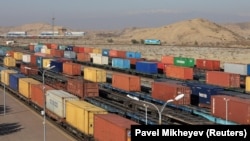Moving shipping containers from China through Russia to the European Union became a vital part of Beijing's Belt and Road Initiative (BRI), but Moscow’s invasion of Ukraine and the Western sanctions that followed have forced China to search for alternatives.
Faced with the economic fallout of trade disruptions after five months of war, many freight forwarders that move Chinese goods are looking further south to move rail-cargo across Central Asia, the Caucasus, and Turkey to Europe despite long-standing logistical problems with the route.
“In order to survive, the BRI has no alternative but to adapt to the new circumstances.” Andreea Brinza, vice president of the Romanian Institute for the Study of the Asia-Pacific, told RFE/RL.
The main alternative is the roughly 6,500-kilometer network of roads, railroads, and ports stretching across Kazakhstan, the Caspian Sea, Azerbaijan, Georgia, Turkey, and into Europe known as the Trans-Caspian International Transport Route (TITR).
It's also known as the Middle Corridor of the BRI -- the globe-spanning infrastructure and investment project championed by Chinese President Xi Jinping.
The route has received billions of dollars in Chinese investment in infrastructure over the last decade but received a smaller share of shipments due to cost and predictability concerns. As a result, Russian trains -- which brought goods directly to Europe by rail or port, or entered via Belarus -- became the main path for Chinese-EU overland trade, making up 68 percent of westbound traffic and 82 percent of eastbound traffic in 2021.
But that changed sharply following the Kremlin’s February invasion of Ukraine.
According to the Trans-Caspian International Transport Route Association, cargo shipments across Central Asia and the Caucasus are expected to reach 3.2 million metric tons in 2022, a sixfold increase over the previous year. The route also received a boost in April when Maersk, one of the world’s largest shipping corporations, canceled new bookings through Russia and started a train service along the Middle Corridor, which was joined by the Finnish company Nurminen Logistics in May.
Since then, multiple governments along the route -- from Turkey to Romania to Azerbaijan to Georgia to Kazakhstan -- have met to discuss further investment and deepening cooperation, including a state visit to Ankara in May by Kazakh President Qasym-Zhomart Toqaev, where he discussed the future of the route with his Turkish counterpart, Recep Tayyip Erdogan.
The refocus on shipments away from the Russian route also received the backing of many Chinese logistics companies, which had previously neglected the Middle Corridor as being unprofitable and vaguely defined.
“The combination of the preexisting interest [from governments along the route] and China’s limited options because of the war made the Middle Corridor possible,” Brinza said. “But [the] main driver of this route was China.”
Searching For Alternatives
The change marks a substantial and quick reversal of fortune for the TITR and opened up new possibilities for countries in Central Asia and the Caucasus.
The northern rail network through Russia was increasingly boosted by both Chinese and Russian officials as they deepened their ties, and it won over freight forwarders and cargo companies during the COVID-19 pandemic as an alternative to ocean transport because ports around the world closed or curtailed operations to try to stop the spread of the virus.
In 2018, Russian President Vladimir Putin ordered the state monopoly Russian Railways to substantially grow container traffic and -- prior to its invasion of Ukraine -- Moscow said it expected container flows to increase to 3.6 million boxes by 2035.
During that span, Beijing worked hard to subsidize, promote, and make profitable those railway lines and the efforts led to a 50 percent increase in cargo transported in 2020, a marked improvement from only a few years previously when trains mostly ran empty on the eastward route back to China.
As transit across Eurasia grew, the northern shipping route through Russia was boasted about as a BRI success story, with Chinese officials saying that it “provided continental supply chain stability.”
But with many large companies and shipping firms unable or unwilling to rely on transport through Russia, a substantial hole has been created and many governments are trying to capitalize by filling it.
Kazakhstan has announced plans to invest more into its ports along the Caspian Sea and its state-run railway operator Kazakhstan Temir Zholy reported that terminals along its western coast have already doubled their shipping volume.
Chinese officials have also moved to simplify transport, with Wang Lingjun, deputy minister of China’s General Administration of Customs, saying on May 25 that Beijing is improving its customs procedures at the Alashankou and Khorgos land ports on its border with Kazakhstan that would lead to increased volumes of goods being sent by rail.
Adapting To The Future
While the Middle Corridor is experiencing a boom because of the war in Ukraine, its future viability is far from guaranteed, says Emil Avdaliani, the director of Middle East studies at the Georgian think tank Geocase and a professor at the European University in Tbilisi.
Concerns largely stem from higher costs and more complicated logistics on the southerly route. While critical infrastructure is in place, some of which is the result of BRI projects, the geography of the Middle Corridor -- which consists of sea and land lines -- is more complex.
“The Middle Corridor also lacks infrastructure in the Caspian Sea for easier transit from Central Asian ports to Azerbaijan. Similar troubles beset the Georgian side of the Black Sea, especially since there is no deep-sea port,” Avdaliani said.
The construction of a deep-water port in Anaklia was embroiled in Georgia’s tumultuous domestic politics and the project was canceled by the government over concerns about financing. But Georgian Deputy Prime Minister Levan Davitashvili said in April that the venture has received new investor interest, even though its construction would still take years.
Avdaliani says domestic political concerns in many of the countries along the Middle Corridor are part of what propelled the Russian line to take on the majority of the overland freight shipments and that Beijing is unlikely to be satisfied relying on one route again. He says China may instead be looking to diversify and build up as many alternative lines as possible in the aftermath of the war in Ukraine.
A renewed push from Tashkent and Bishkek has led to progress on the long-delayed China-Kyrgyzstan-Uzbekistan railway project and all three parties said they hoped for construction to begin next year, which could help provide more alternatives and even be linked to countries further south, such as Turkmenistan and Iran.
“We often tend to portray the BRI as a static initiative, but [like] all trade routes throughout history, the BRI is fluid and is adapting to [new] challenges and opportunities,” Avdaliani says. “Closed borders require finding new routes and this is what is happening at the moment.”











